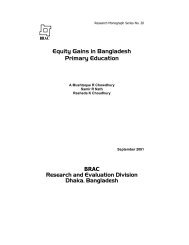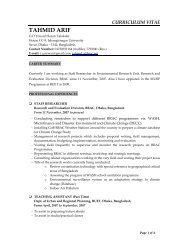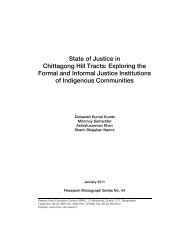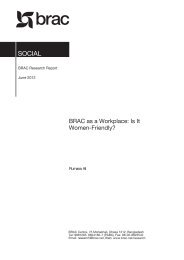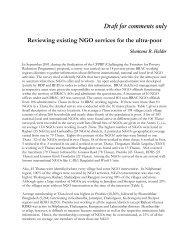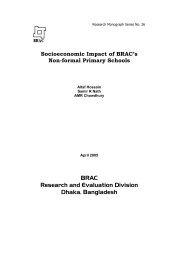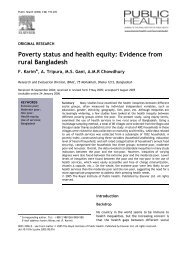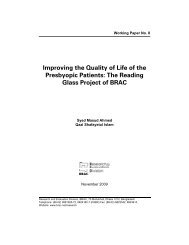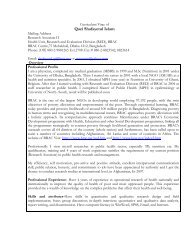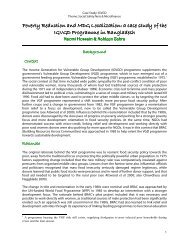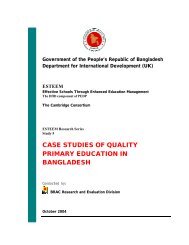Combining health and social protection measures to reach the ultra ...
Combining health and social protection measures to reach the ultra ...
Combining health and social protection measures to reach the ultra ...
You also want an ePaper? Increase the reach of your titles
YUMPU automatically turns print PDFs into web optimized ePapers that Google loves.
Access <strong>to</strong> <strong>health</strong><br />
✜ Rights alone are not enough, but need <strong>to</strong> be coupled with community<br />
engagement.<br />
✜ Rights, appropriately applied, can streng<strong>the</strong>n community engagement.<br />
✜ Rights, conceived in terms of agency, are <strong>the</strong> strongest guaran<strong>to</strong>rs of<br />
effective equity-promoting impacts.<br />
✜ Rights should streng<strong>the</strong>n <strong>the</strong> collective agency of <strong>the</strong> most vulnerable<br />
groups.<br />
✜ Rights approaches should aim <strong>to</strong> address <strong>the</strong> public-private <strong>and</strong> global<br />
divides in relation <strong>to</strong> human hights.<br />
✜ Information <strong>and</strong> transparency are key <strong>to</strong> human rights approaches that<br />
build equity.<br />
✜ Human rights approaches provide additional opportunities for<br />
mobilizing resources outside <strong>the</strong> <strong>health</strong> sec<strong>to</strong>r.<br />
Table 1: Human rights <strong>and</strong> <strong>health</strong> equity – critical success fac<strong>to</strong>rs<br />
levels, <strong>the</strong> erosion of civil society structures post apar<strong>the</strong>id<br />
that accompanied <strong>the</strong> formalization of local government<br />
structures led <strong>to</strong> a decline in political accountability <strong>and</strong><br />
alienation of communities from decision-making processes<br />
with regard <strong>to</strong> housing <strong>and</strong> sanitation 15 .<br />
Secondly, rights frameworks provide opportunity <strong>to</strong><br />
reinforce community engagement by affording a mechanism<br />
for input <strong>to</strong>, <strong>and</strong> negotiation around <strong>health</strong> policy. Concern for<br />
procedural rights is becoming increasingly important in<br />
<strong>health</strong> 17-19 <strong>and</strong> development discourse 15,20 <strong>and</strong> has been<br />
recently applied in <strong>the</strong> Equity Gauge model, which uses<br />
policy <strong>and</strong> moni<strong>to</strong>ring information, channelled <strong>to</strong><br />
communities <strong>and</strong> civil society, for political action <strong>to</strong> influence<br />
policy-makers <strong>to</strong> support a <strong>health</strong> equity agenda 1 . Procedural<br />
rights are <strong>the</strong>refore key <strong>to</strong> enabling <strong>the</strong> realization of o<strong>the</strong>r<br />
rights, as has been shown in many areas related <strong>to</strong> <strong>health</strong>,<br />
such as in reproductive <strong>health</strong> 21 <strong>and</strong> in housing/sanitation 15 .<br />
Thirdly, rights frameworks that address issues of power in<br />
recognizing agency of those affected by <strong>health</strong> policy, are <strong>the</strong><br />
strongest guaran<strong>to</strong>rs of effective equity-promoting impacts.<br />
Considerable evidence already exists that <strong>the</strong> root causes of<br />
<strong>health</strong> inequalities relate <strong>to</strong> powerlessness of both individuals<br />
<strong>and</strong> groups. Such power differentials give rise <strong>to</strong> a sequence<br />
of processes: <strong>social</strong> stratification, differential exposure based<br />
on <strong>social</strong> stratification, differential vulnerability given an<br />
exposure <strong>and</strong> differential consequences, which combine <strong>to</strong><br />
give rise <strong>to</strong> <strong>health</strong> inequities 22 . Attempts <strong>to</strong> redress inequities,<br />
which are inherently about <strong>social</strong> change, <strong>the</strong>refore have <strong>to</strong><br />
grapple with questions of power 23 , <strong>and</strong> must consequently<br />
seek interactions with communities that focus on<br />
empowerment ra<strong>the</strong>r than mere participation 24 . Hard as it<br />
may be <strong>to</strong> manage, an active civil society is a better guarantee<br />
of <strong>health</strong> equity than models which frame target groups by<br />
need <strong>and</strong> deliver services <strong>and</strong> resources <strong>to</strong> passive<br />
beneficiaries. Indeed, in public <strong>health</strong> debates, <strong>the</strong>re has<br />
been an increasing support for a return <strong>to</strong> <strong>the</strong> spirit of Alma<br />
Ata, <strong>to</strong> revive <strong>the</strong> notion of community agency in public<br />
<strong>health</strong> practice, <strong>and</strong> <strong>to</strong> take seriously our commitment <strong>to</strong><br />
community empowerment 25-28 . We hear endless appeals <strong>to</strong>,<br />
<strong>and</strong> laments about <strong>the</strong> lack of political will <strong>to</strong> address key<br />
<strong>health</strong> problems. An active engagement by civil society<br />
means we no longer have need <strong>to</strong> resort <strong>to</strong> a concept of<br />
political will, given we commit <strong>to</strong> a model where “those who<br />
are beneficiaries of programmes… negotiate <strong>the</strong>ir inclusion in<br />
<strong>the</strong> <strong>health</strong> system” constituting “organized <strong>and</strong> active<br />
Considerable evidence already exists that <strong>the</strong><br />
root causes of <strong>health</strong> inequalities relate <strong>to</strong><br />
powerlessness of both individuals <strong>and</strong> groups<br />
communities at <strong>the</strong> centre as initia<strong>to</strong>rs <strong>and</strong> managers of<br />
<strong>the</strong>ir own <strong>health</strong>” 28 .<br />
Fourthly, most evident in <strong>the</strong> EQUINET case studies was<br />
<strong>the</strong> role of rights approaches as critical <strong>to</strong> streng<strong>the</strong>ning <strong>the</strong><br />
collective agency of <strong>the</strong> most vulnerable groups. Advocacy<br />
work in areas such as HIV treatment access <strong>and</strong> in bringing<br />
community preferences <strong>to</strong> bear on national <strong>health</strong> policies<br />
plays a key role in reversing <strong>the</strong> “thinness of reserves” 22<br />
characteristic of groups suffering <strong>health</strong> inequities. In this<br />
sense, <strong>the</strong> public <strong>health</strong> approach of targeting populations<br />
according <strong>to</strong> need, <strong>and</strong> <strong>the</strong> priorization of <strong>the</strong> most vulnerable<br />
<strong>and</strong> marginal groups as a human rights concern represent a<br />
synchrony in approaches. What a rights analysis does is <strong>to</strong><br />
add <strong>the</strong> recognition that an inability <strong>to</strong> exercise power means<br />
that <strong>the</strong> poor <strong>and</strong> vulnerable cannot change <strong>the</strong> conditions of<br />
<strong>the</strong>ir vulnerability, <strong>and</strong> must remain dependent on o<strong>the</strong>rs <strong>to</strong><br />
do so 24 . Institutional frameworks for human rights that<br />
preferentially favour access for vulnerable groups, such as, for<br />
example, in <strong>the</strong> identification of evidence in Health Impact<br />
Assessments 29 are <strong>the</strong>refore key <strong>to</strong> realizing <strong>the</strong> libera<strong>to</strong>ry<br />
potential of rights approaches in <strong>health</strong> 5 .<br />
This leads naturally <strong>to</strong> <strong>the</strong> fifth implication – that<br />
information <strong>and</strong> transparency are key elements for <strong>the</strong><br />
achievement of <strong>health</strong> equity. Lack of information <strong>and</strong><br />
transparency undermines community agency, <strong>and</strong> drives<br />
conflict <strong>and</strong> distrust that prevents redress of inequity. For<br />
example, <strong>the</strong> closure of channels of access <strong>to</strong> information<br />
regarding Poverty Reduction Strategy Papers in Malawi has<br />
been interpreted as reversing gains made through interaction<br />
with policy-makers over o<strong>the</strong>r policies such as <strong>the</strong> national<br />
Patients Rights Charter 5 . It is both at an individual <strong>and</strong><br />
collective level that information serves <strong>to</strong> reverse <strong>the</strong><br />
powerlessness underlying <strong>health</strong> inequalities. Central <strong>to</strong> <strong>the</strong><br />
model of <strong>the</strong> Equity Gauge 1 is <strong>the</strong> role of information in<br />
empowering community partners <strong>to</strong> advocate for action.<br />
Similarly, in <strong>the</strong> case studies for EQUINET, civil society was<br />
both a user <strong>and</strong> genera<strong>to</strong>r of information, through strategic<br />
partnerships with research <strong>and</strong> academic experts that<br />
enabled organizations <strong>to</strong> lobby for policy change <strong>to</strong> advance<br />
<strong>the</strong> interests of vulnerable communities 5 . Access <strong>to</strong><br />
information is thus both a right in itself <strong>and</strong> an enabling<br />
mechanism <strong>to</strong> realize o<strong>the</strong>r rights. Policy-makers can<br />
<strong>the</strong>refore play a critical role in ensuring that information<br />
accessibility <strong>and</strong> transparency are not only part of public life,<br />
but are geared <strong>to</strong>wards <strong>reach</strong>ing marginalized, isolated <strong>and</strong><br />
vulnerable groups as a priority.<br />
A fur<strong>the</strong>r consequence of rights-based approaches <strong>to</strong> <strong>health</strong><br />
equity is <strong>the</strong> capacity <strong>to</strong> address <strong>the</strong> public-private <strong>and</strong> global<br />
divides that may not be initially obvious <strong>to</strong> law-makers.<br />
Illustrated most clearly in <strong>the</strong> HIV treatment access<br />
Global Forum Update on Research for Health Volume 4 ✜ 055



